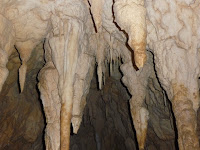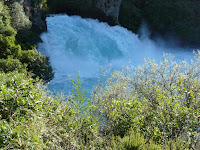 We had completed the competition; we had not completed the journey. Middle Earth’s North Island would present a different set of challenges and landscapes as we set out on the journey home. This land of fire, ice and the underworld would further test our mettle, while rewarding the valiant traveler with unforgettable experiences and additional vistas of unparalleled beauty.
We had completed the competition; we had not completed the journey. Middle Earth’s North Island would present a different set of challenges and landscapes as we set out on the journey home. This land of fire, ice and the underworld would further test our mettle, while rewarding the valiant traveler with unforgettable experiences and additional vistas of unparalleled beauty.We first ventured into the land of fire and ice in Rotorua and its beautiful namesake lake – nestled in an ancient crater. A sky tram took us to a summit

 overlooking the lake and the valley of geothermal activity, from whence we descended in luges; however, this was not before Karen tasted of the Land’s spirit of adventure, being dropped from a tower and accelerating to mind-numbing speed in a swing of fabled proportions. Having maneuvered off the mountain, we partook of the agricultural legacy of the land – witnessing firsthand the relationship of sheep to Middle Earth’s inhabitants.
overlooking the lake and the valley of geothermal activity, from whence we descended in luges; however, this was not before Karen tasted of the Land’s spirit of adventure, being dropped from a tower and accelerating to mind-numbing speed in a swing of fabled proportions. Having maneuvered off the mountain, we partook of the agricultural legacy of the land – witnessing firsthand the relationship of sheep to Middle Earth’s inhabitants. 
 Rainbow Springs introduced us to the Land’s immense trout and our night culminated with the song, dance, food and history of the Maori tradition.
Rainbow Springs introduced us to the Land’s immense trout and our night culminated with the song, dance, food and history of the Maori tradition.


Two major obstacles remained in our path – we must navigate the dark underworld and traverse the final quarters of fire and ice, to include crossing through the twin volcanoes of Mounts Doom and Tongarairo. We set out next to do the latter – the famed alpine crossing in the Tongarairo (NP) wilderness. However, the elements conspired against us and we were forced to retreat to the Falls of Teranaki –
 beautiful in their own right, but far short of the volcanoes through which we needed to pass. Storms then forced us into the dark caverns of Waitomo, where we successfully navigated Waitomo and Ruakuri caves and the total darkness that gave way to thousands of spots of light on the cavern roofs where glow worms reside and feast on insects brought into the caves by the black waters channeled through the darkness – the same black waters Karen rafted through on the rings of life, th
beautiful in their own right, but far short of the volcanoes through which we needed to pass. Storms then forced us into the dark caverns of Waitomo, where we successfully navigated Waitomo and Ruakuri caves and the total darkness that gave way to thousands of spots of light on the cavern roofs where glow worms reside and feast on insects brought into the caves by the black waters channeled through the darkness – the same black waters Karen rafted through on the rings of life, th rough gorges and through falls to complete our travel through the treacherous darkness.
rough gorges and through falls to complete our travel through the treacherous darkness.


Fire and ice remained. First, we needed to cross the Thermal Quarter, with its violent mud pots, fiery pools, silica terraces and boiling geysers. Our track would take us through Hell’s Gate and the Hidden Valley of Korako Orakei. We traversed Hell’s Gate in the day’s early hours – skirting formations and evidence of the power of Middle Earth’s fire – and reminiscent of similarly stark landscapes a day’s journey from our home land. As the sun set, we completed the trail through the Hidden Valley of Korako Orakei – a surreal landscape of terraces, mud volcanoes and fumaroles. We were nearing our journey’s end.


It was only fitting that the moon filled the night sky as we prepared for the final trek. During the previous day and night, the season’s first snow had blanketed the highlands and the cold gales reminded everyone that the Tongarairo Alpine Crossing was not for the faint of heart.


In the early morning hours we assembled with dozens of other pilgrims at the Trails’ Head – many of whom looked at us skeptically – with Rachel perched on my back. However, we believed we were prepared and dressed to brave the elements and we set out, quickly gaining elevation through the Mangatepopo Valley into the highlands below the volcanoes. Clouds and mist allowed only intermittent views of our destination through the high pass, but we passed Mangatepopo Hut and after a brief respite at Soda Springs began the steep steppes to South Crater.


From here, the ascent to Red Crater became increasingly more treacherous – the trail covered in snow and ice and the cold gales increasingly fierce. We passed many travelers who had decided to return another day and many who continued to inch along.
 We also were confronted by angry pilgrims who thought we were unfit parents to have our daughter out in the elements and on the Track under these conditions. We pressed on – occasionally rewarded by clear views of the ominous volcanic profile of Mt. Doom. We safely reached the summit near Red Crater, with the hissing of steam evident and the color of sulphur on all sides.
We also were confronted by angry pilgrims who thought we were unfit parents to have our daughter out in the elements and on the Track under these conditions. We pressed on – occasionally rewarded by clear views of the ominous volcanic profile of Mt. Doom. We safely reached the summit near Red Crater, with the hissing of steam evident and the color of sulphur on all sides.



With the weather taking its toll, we did not tarry, but began the descent into Emerald Lakes – with their mystic and beautiful colors set against the volcanic plain. With the track clearing and Rachel faring better, we continued through Central Crater and past Blue Lake before beginning the long descent to Ketetahi Hut, where we tarried shortly with friendly travelers before completing the Crossing in the late afternoon. We had surmounted the final obstacle and met the final challenge. Our time in Middle Earth was drawing to a close.


 Tired, but satisfied, we returned to our carriage and headed north. Based on the advice of fellow travelers on the Alpine Crossing our destination was Mount Maunganui, referring to both the town and Mount on Middle Earth’s east shore – our last opportunity to actually see and spend time on the South Pacific coast.
Tired, but satisfied, we returned to our carriage and headed north. Based on the advice of fellow travelers on the Alpine Crossing our destination was Mount Maunganui, referring to both the town and Mount on Middle Earth’s east shore – our last opportunity to actually see and spend time on the South Pacific coast.

We finally found lodging and the next morning were rewarded with beautiful white sand beaches,
 contrasted against the azure blue waters of the Pacific, black volcanic rock along the shore and the green slopes of Mt. Mauganui at the head of the small bay. We spent time on the beach, climbed the Mount and marveled at the beauty that we had not yet seen. The time was short, but more than worthwhile as a fitting conclusion to a wonderful trip – where only the final drive to Auckland and the airborne journey home remained.
contrasted against the azure blue waters of the Pacific, black volcanic rock along the shore and the green slopes of Mt. Mauganui at the head of the small bay. We spent time on the beach, climbed the Mount and marveled at the beauty that we had not yet seen. The time was short, but more than worthwhile as a fitting conclusion to a wonderful trip – where only the final drive to Auckland and the airborne journey home remained.

We departed Middle Earth in the evening – and to make amends for the lost day of our inbound voyage – we arrived in Los Angeles that same day, but in the morning hours. It was a trip to remember. Middle Earth lived up to every expectation – in fact, exceeded each one. It was a beautiful Land where the promise of outdoor adventure never waned and where the senses were continuously overwhelmed by the Land’s bounty. No doubt the Land will call again – and once again we will heed the call.




















